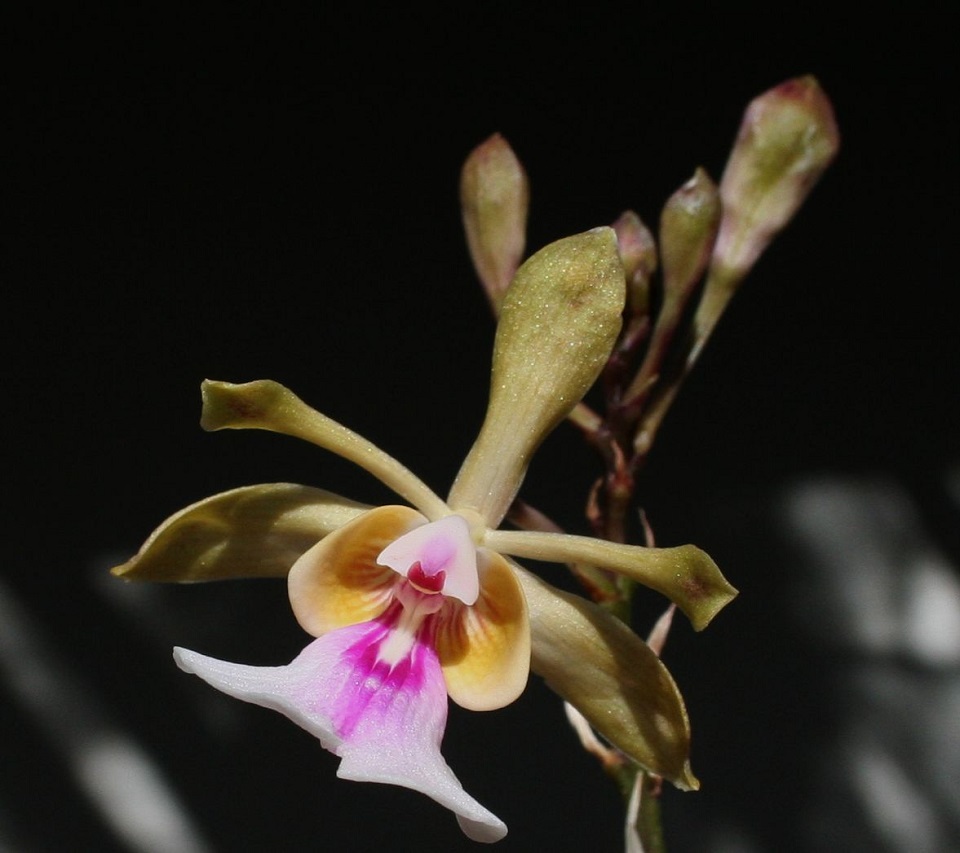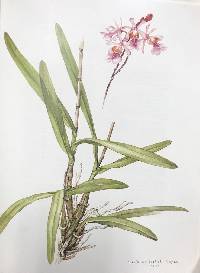
Distribution: Found in the Virgin Islands and Puerto Rico as a small to medium sized, hot growing lithophyte or epiphyte at elevations of sea level to 340 meters with cylindrical, longitudinally rugose with age, 3 noded pseudobulbs enveloped basally by a few scarious sheaths and carrying 2 apical, linear, obtuse, basally clasping leaves that blooms on a terminal, to 5' [150 cm] long, arching, several to many flowered inflorescence that can rebloom for years and occuring at any time of the year but mainly March through August.
Plants tough, usually caespitose epiphytes, occasionally growing terrestrially. Roots numerous from short stout rhizomes, 3-4 m m diam. Pseudobulbs cylindrical to pyriform, to 18 cm long. Leaves 2-4, stiff, coriaceous, linear-oblong, margins minutely toothed, 10-28 cm long, 0.8-3.0 cm wide. Scapes terminal, erect, stiff, partially covered by tubular scarious sheaths, 0.5-1.5 m long. Inflorescences short racemes, 1 to few lateral racemes produced near apex of scape on older shoots; buds and flowers clustered, produced sequentially; floral bracts scarious, ovate, acuminate, 1-3 m m long. Flowers showy, of various shades of red to lavender, sometimes blotched, resupinate. Pedicellate ovary slender, 2-3 cm long. Sepals oblong-oblanceolate, obtuse, 1.5-2 cm long, 4-7 m m wide. Petals linear-oblanceolate, obtuse, 1.5- 2 cm long, 3-4 m m wide. Lip with dark lines, trilobed, attached to basal half of the column; lateral lobes obovate, erect, flanking the column, 12 m m long, 8-10 m m wide; middle lobe obcordate, deeply notched; callus basal, bifid, elliptic, situated beneath the column; free portion of the lip with 3 parallel ribs, 2-2.8 cm long, 1.5-2.6 cm wide. Column straight, 5-9 m m long; pollinia yellow. Fruits ellipsoidal, 2-3.2 cm.
The lips has three longitudinal ribs and is nearly 3 cm long and almost as broad. Psychilis macconnelliae has been the source of much taxonomic confusion. Until recently it has been regarded as either Epidendron bifidum Aublet or Encyclia bifida (Aublet) Britton & Wilson, both of which are synonyms of Psychilis bifia (Aublet) Sauleda, a species confined to northern Hispaniola. While rare and confined to a few localities on the eastern shores of Puerto Rico, endemic Psychilis macconnelliae is not uncommon on nearby islands, including Vieques, Culebra and the Virgin islands.
Pollinators of P. macconnelliae are unknown, bt the reporductive biology of the orchid is very similar to P. krugii and P. kraenzlinii.
Copyright ©2018. This project is managed by the St. George Village Botanical Garden and the portal development is powered by Symbiota software. Usage Policy.




